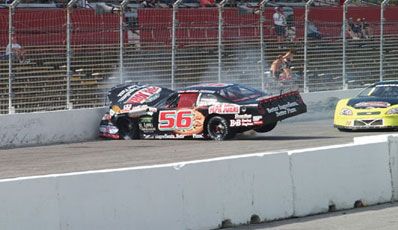
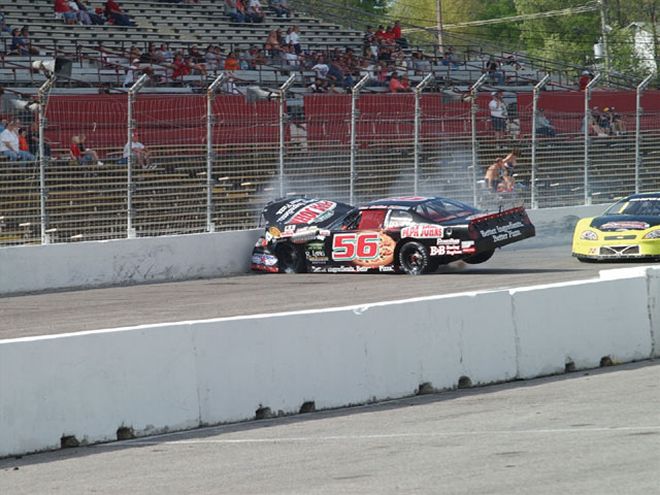
When was the last time you were at a race that went caution free? Yeah, that's what we thought. Accidents are a part of racing, and at some point we are all going to be involved in at least one. It's not a matter of "if" but "when." Many different things can happen to your safety equipment in an accident, one of the most obvious being belt stretch. This is so commonplace that some tracks even cut your belts out of the car after a hard hit to ensure that you replace them before racing again.
While belt stretch is obvious, there is a potentially more sinister result of a hard hit and that has to do with your head. A good helmet is essential to racing safely and you should always check your helmet carefully after a hard wreck. Spiderwebbing or outright cracks are obvious damage but is it possible to damage a helmet's interior beadliner, thus compromising its integrity, without cracking the outer shell?
We decided to find out if the Phantom Impact exists.
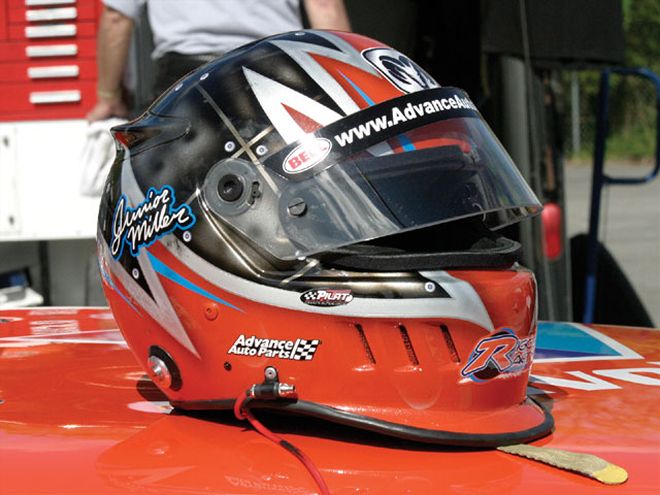 Check carefully. Ornate designs like this one can hide cracks. Todd Ridgeway
Check carefully. Ornate designs like this one can hide cracks. Todd Ridgeway
Our theory started out that if you are wearing a head/neck restraint such as a HANS Device and you crash, the helmet gets restrained but your head keeps moving within the helmet. Since the inner liners of helmets have some amount of give to them, after all that is how they protect your noggin, when your head keeps moving it will damage the inner liner. To find out if our theory held water we contacted five major helmet manufacturers, a head and neck restraint company and an independent industry expert.
Interestingly they had differing opinions on whether or not you could actually damage an inner liner without hitting your head against something. Much of this has to do with a lack of data. "I don't know that anybody has ever measured the liner crush due to an SFI test," admitted HANS' Dr. Bob Hubbard. "The head accelerations in an SFI 38.1 test for head and neck restraints (HNR) are typically below 100g. The accelerations in Snell helmet testing are typically 300g or more. So, the acceleration and associated loads on the helmet liner in the SFI test are much less than for the Snell test."
So, while there is no specific test for our theory we did find out some extremely important factors about the Phantom Impact.
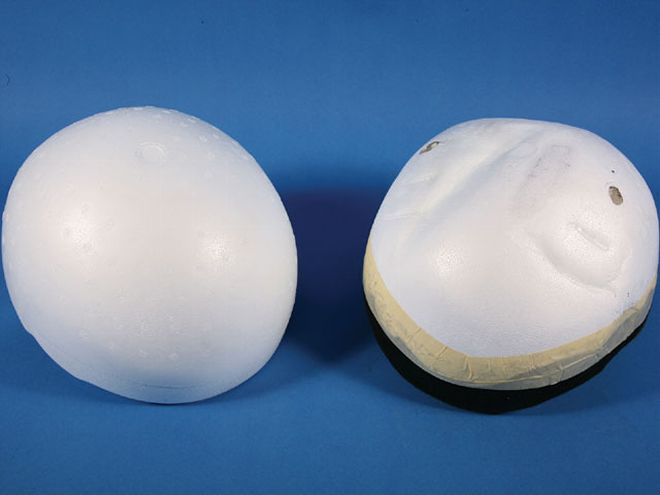 The EPS inner liner on the right is damaged and obviously compromised. If you're liner looks like this, the helmet is junk. Your liner should always look like the one on the left.
The EPS inner liner on the right is damaged and obviously compromised. If you're liner looks like this, the helmet is junk. Your liner should always look like the one on the left.
"Sometimes the evidence is not visible," says Bell's Kyle Keitzman. "During the 2006 Indianapolis 500, Darren Manning backed into the wall. The impact generated over 100g but there was no outward damage to the helmet's shell, however you could actually see the outline of the back of his head in the lining."
If you hit the wall hard enough that you can see the outline of your head in the inner liner, it's safe to say that your helmet is now junk. Every helmet manufacturer we talked to for this story told us the same thing-if that inner liner is damaged there is no way possible that it will provide the same level of protection in another accident. And that is the danger of the Phantom Impact.
But what about the not so obvious damage? Let's say you have a crash and you inspect the helmet, looks good on the outside, looks good on the inside. It's fine right? Wrong.
"There could definitely be non-visible damage," says Gary Peters of Simpson Race Products. "Hairline cracks in the shell could be hidden by a helmet's paint job, especially ornate designs with a lot of color changes, lines, etc."
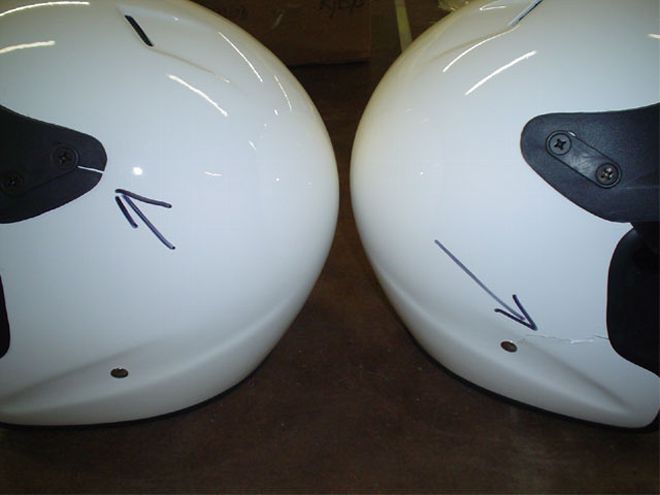 This is a major crack and the helmet needs to be trashed.
This is a major crack and the helmet needs to be trashed.
Peters told a story of when Hank Parker Jr. was involved in a high-speed crash in a Craftsman Truck where he recorded one of the highest g-force impacts ever. "He did have a HANS on," said Peters. "I took the whole helmet apart myself and couldn't find anything wrong with it."
However, that doesn't mean that the helmet wasn't damaged and shouldn't have been junked (which by the way it was). There are two types of helmet inner liners, EPS or expanded poly styrene and EPP or expanded poly propylene. EPS (the common white liner) will show visible damage after an impact. Upon impact, the liner deforms and does its job of protecting your head. You can easily see dents and deformation after taking an EPS helmet apart.
However with EPP, you may never see the damage. EPP has a memory, conceptually similar to the Tempurpedic mattress, and will return to its original shape even after being subjected to a tremendous force such as Parker Jr's. So even though the EPP returns to its shape, its ability to keep you safe from additional impacts is compromised. This is compounded in accidents where you take multiple hits.
"In a multiple-impact accident, you use up the helmet's ability to attenuate an impact after the initial hit," says Peters. "The second and third hit will further compromise the helmet."
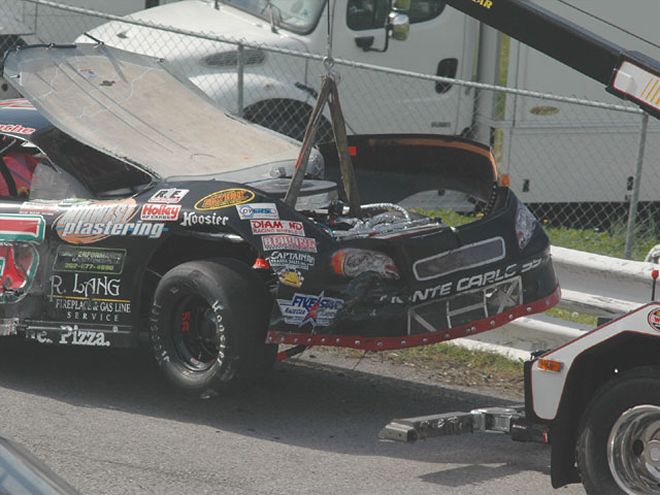 A good rule of thumb is that if you need the hook, you need, at the very least, to inspect your helmet. Kevin Thorne
A good rule of thumb is that if you need the hook, you need, at the very least, to inspect your helmet. Kevin Thorne
A compromised helmet will not, in any way shape or form, protect you as well as a brand new one. In essence, if the first wreck didn't get you, the next one will. And don't pull that "it won't happen to me" argument. Even the best racers in the world have had more than one hard wreck in their careers. Race long enough and you can bet it will happen.
Guidelines Okay, you've been in a crash and you're not sure if you should replace your helmet or not. Here are a couple of tips to help you along.
Step 1. Check the entire outer shell of the helmet to see if there is any delamination, spiderwebbing (hairline cracks that look like a spider's web) or larger cracks, paying extra close attention to areas that may be painted. If there are, don't even go to step two, you need a new helmet.
Step 2. Look closely at your head and neck restraint mounting bolts, this is an area of high stress in an accident and if the hit is hard enough, there may be cracking at that spot of the helmet.
Step 3. Once you've determined that the outer shell has no damage, look at the inner liner. You are looking for any signs of compression such as indentations or a misshapen liner.
Step 4. Remove the inner liner and inspect it closely. While it's out, also look for any damage to the outer shell from the inside. However, only do this if you have a removable inner liner. If you don't, you could very easily damage the helmet.
If you have a shred of doubt as to the condition of your helmet, send it to the manufacturer for inspection. The manufacturers we talked to for this story will all inspect potentially damaged helmets free of charge. Remember the bottom line is just because it looks good, doesn't mean it is good. All of our manufacturers said that if you have a bad wreck you need to send the helmet back to them for a professional evaluation.
Getting back to our original theory of can you have liner-crush without hitting your helmet against something, we consulted John Melvin, Ph.D. Dr. Melvin is an independent consultant on safety who has worked with GM, NHRA and NASCAR. He brought up a very important point. "One of the big problems is that everybody's head is different. Helmets don't fit everybody's head exactly, whether it's the overall shape of your head or a bump on your head that is pressing more on one spot of the inner liner than another. So, it is conceivable that in a heavy crash with head and neck restraint pulling on the helmet you, in fact, can locally deform the helmet."
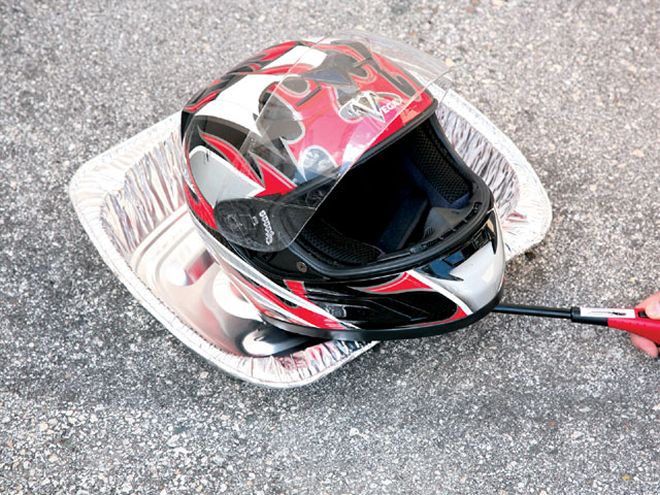 Flame On!
Flame On!
Melvin says that the solution is to make sure that you have a good fit. Just because one brand's medium doesn't fit exactly right doesn't mean that another one's won't. When helmet shopping, you should buy based on fit, not on brand or marketing.
And that's what this little research project brought to light. As racers, we spent untold hours tweaking our valvetrain combinations to get just the right amount of power. We spend days on end fussing with the setup just to get that exact handle on our car. We need to pay just as much attention to the one piece of safety equipment where fit is more critical than any other, your helmet.
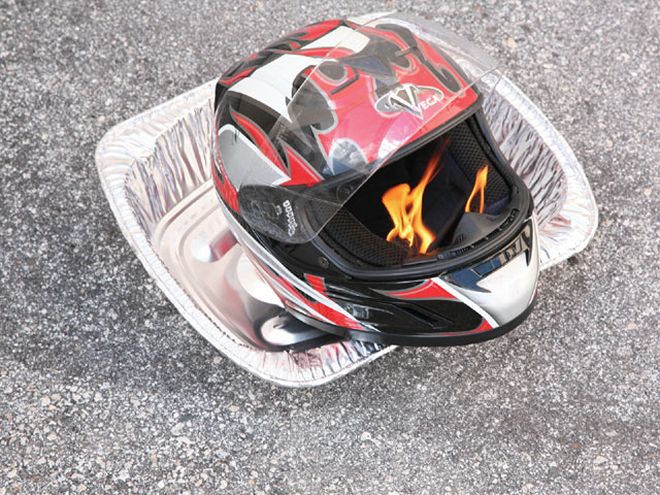 After just six seconds, your cheeks are burning.
After just six seconds, your cheeks are burning.
In the course of this story, we had a number of helmet manufacturers bring up the fact that if you race cars, you should not wear a motorcycle helmet. While just about every track and sanction specify Snell rated helmets, some do not differentiate between the Snell Rating for motorsports SA-2005 or those for motorcycles M-2005. Consequently, at some tracks you can legally race in a cheap Snell-rated motorcycle helmet. However, that could be the worst decision of your life. Motorcycle helmets are not made for racecars. First of all, most motorcycle helmets are not made with fire retardant materials. They don't have to be. They are designed to absorb impacts of your head bouncing off the ground going 55 mph, not protect you from fire.
"On these things (motorcycles) you slide away from the fire, in a car, you're trapped in the fire," says AMA motorcycle racer Glen Castle.
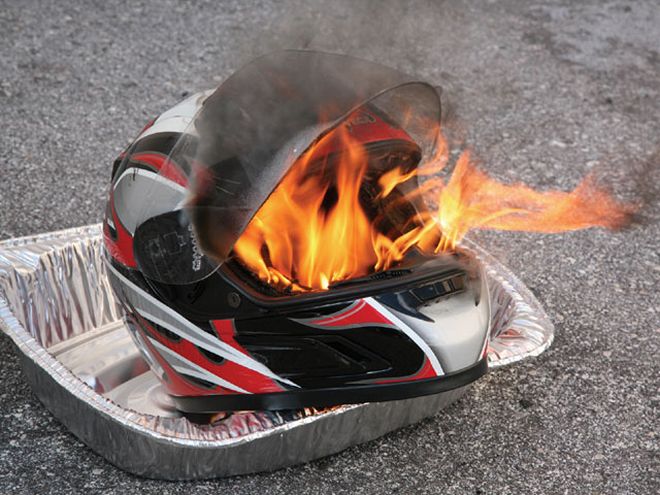 Nineteen seconds and the faceshield is melting.
Nineteen seconds and the faceshield is melting.
Any helmet manufacturer worth their weight in padding will tell you the same thing. And in fact, many take steps to prevent racers from buying the wrong helmet. For example, Simpson's policy is that they won't install HANS clips on a motorcycle helmet.
HANS clip mounting aside, we decided to find out just what happens when you have a motorcycle helmet that gets near a little heat. (Our apologies to the ozone layer.)
Think about these pics next time you go helmet shopping and remember to buy the right helmet, there are plenty of SA-2005 helmets that are value priced. The moral of this exercise? Don't wear a motorcycle helmet, it can melt to your head.